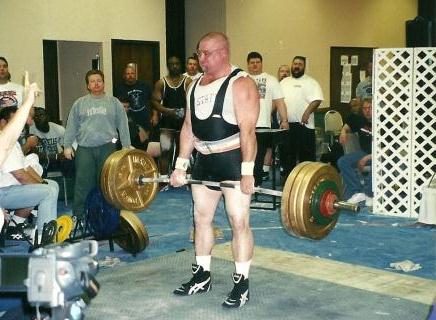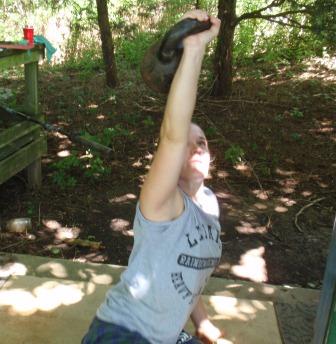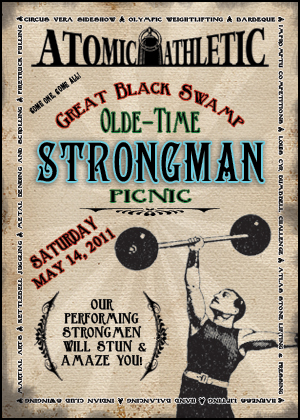Why the Deadlift is the BEST LIFT
by Al Myers

This is one of several 700 pound plus deadlifts that I did in powerlifting competitions through the years. This picture is from the 2002 NASA Natural Nationals Powerlifting Championships.
I know – this is a bold statement I just made. But after years of training experience, I truly believe that the deadlift is the best exercise for building overall body strength and power. I know there are people who would disagree with me on this statement, and I’m sure they have their reasons, but let me explain my feelings behind this and then you can give your arguments!
1. Argument 1 – The Squat is the KING of LIFTS
Early on I thought the Squat was the KING of LIFTS (and I’m sure others think this as well), and the squat is by far the best lower body exercise, but other than that the deadlift RULES. Very little upper body muscles come into play while squatting compared to a deadlift. The deadlift works EVERY MUSCLE – lower and upper. A deadlift hits the thighs, hamstrings, lower back, upper back, and even the chest muscles. Plus it works the forearm and hand muscles. A squat doesn’t do that! Just name a lift that works all the muscles like a deadlift does – I bet you can’t name one!
2. Argument 2 – The Deadlift will make you slow
I know the “deadlift critics” will say that the deadlift will make you slow. I just don’t believe that. The “critics” are usually ex-Olympic lifters who favor the Clean & Jerk and Snatch and are poor deadlifters (mainly because they don’t like it and don’t train it). Now – I’m not saying these two Olympic lifts are not great lifts (they both make my top five), but for building overall body strength they pale in comparison to the deadlift. The Olympic lifts are highly technical and unless you are training them exclusively you have a hard time maintaining the proper techique and ability in them. Add in a little age and decreased flexibility, and both of these lifts are limited by your technique and not by your strength. And by the way, I have seen several Clean and Jerks that were PAINFULLY SLOW – so don’t use the “explosive” argument with me. Any exercise can be done in an “explosive manner”. Just use less weight and increase your speed of execution!
3. Argument 3 – I don’t want to hurt my back
The argument of not wanting to hurt your back by AVOIDING the best back exercise known to man does not even make sense to me! Exercise strengthens the muscles and prevents injury (of course you have to be training correctly, but that’s another issue). Name one exercise that strengthens the back better than the deadlift?? Lots of money has been invested in machines that make this promise – but where are they now? They come and go with different manufacturers but the deadlift remains. That ought to tell you something.
3. Argument 4 – I’m an athlete and not a powerlifter
I hear this all the time. Just because the deadlift is one of the competitive powerlifts does not make it a BAD EXERCISE. Several of my Highland Game friends seem to think the deadlift is an evil lift and has no benefit to a competitive Highland Athlete. Instead, they focus on dangerous lifts like jump squats and lifts on BOSU Balls. But I will tell you – STRONG IS STRONG, and if you want to be strong, you have to train to be strong. And NOTHING makes you strong like the deadlift! This translates to increased ability in ANY strength related sport. I always loved the Caber Toss in the Highland Games the most, mainly because it directly reflected on who the strongest throwers were. I always threw in the more advanced classes and at that level everyone was experienced, and everyone knew how to toss the caber. It was always very apparent who the strongest throwers were when it got to big cabers, because only the strongest guys turned them. Sure the weaker-strength caber tossers looked “picture perfect” with light sticks, but when things “turned ugly” with the big sticks all the weak throwers could do was make their pfiffers look pretty. Great caber tossers like Mike Smith, Jim “the Big Chief” McGoldrick, Ryan Vierra, and Harry McDonald were BULL STRONG. If the deadlift was contested instead of the caber these same guys would have still been on top.
By now you can tell that I am a little partial to the deadlift! But my feeling is that if I was given the choice to train only ONE LIFT – it would be the deadlift. There is just not any other lifting motion as pure as deadlifting. Men have been picking up things off the ground for years and the deadlift strengthens this basic physical function better than any other lift. Of course, these are all just my opinions and I welcome anyone to debate these points on the USAWA Discussion Forum.


